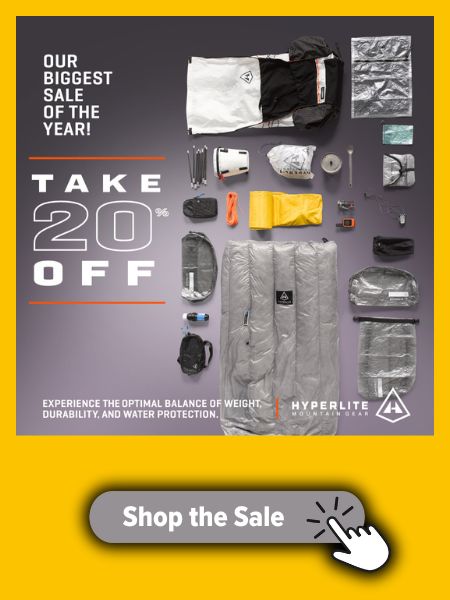Podcast 002 | Dyneema Composite Fabrics
Episode Summary
In this episode, we dive into the design, manufacturing, and applications of Dyneema Composite Fabrics.
Stream:
Subscribe:
- Apple Podcasts | Google Play | Stitcher | Soundcloud | Youtube | RSS

Summary: In this episode, we dive into the design, manufacturing, and applications of Dyneema Composite Fabrics. We interview Wes Hatcher, Applications Manager for DSM Dyneema, along with cottage ultralight backpacking company founders Graham Williams (CiloGear), Mike St. Pierre (Hyperlite Mountain Gear), Joe Valesko (ZPacks), Henry Shires (Tarptent), and Glen Van Peski (Gossamer Gear) and discuss the relevance of Dyneema Composite Fabrics for apparel, shelters, backpacks, and more.
- What are Dyneema Composite Fabrics?
- History and evolution of Cuben Fiber & Dyneema Composite Fabrics
- Role of the Backpackinglight.com MYOG Community in Cuben Fiber applications in the mid-2000s
- Guest Interview: Wes Hatcher
- From the America’s Cup to DSM Dyneema Outdoor Applications: A Brief History
- Dyneema Composite Fabrics: What are they, exactly? A fabric? A fabric family? A process?
- How Dyneema Composite Fabrics are manufactured? What is the material composition of the fibers, adhesive films, and face fabrics/films in DCF?
- What parts of DCF are “Dyneema”, “Mylar”, PET, TPU, PU, polyester/nylon/Dyneema wovens?
- What is the primary advantage of non-woven construction, and how does this advantage contribute to the unique strength of Dyneema Composite Fabrics?
- What are the key performance properties that make DCF different from woven nylons or polyesters?
- What is the environmental/energy cost of producing DCF?
- Vs. other high-strength fibers, or sil/PU-coated wovens?
- Lamination of wovens to DCF – how is load-bearing affected?
- What is the real purpose of laminating a woven nylon, polyester, or Dyneema fabric to a DCF construction?
- What role does DCF play when laminated to waterproof-breathable fabric constructions, such as eVENT?
- Does DCF offer advantages for waterproof-breathable fabric constructions over traditional membrane/coating-fabric sandwiches?
- Product Commentary: Hyperlite Mountain Gear “The Shell” Jacket | Review
- Why is DCF so expensive?
- True or false? Is DSM Dyneema having supply problems with respect to DCF output?
- What technological advances in DCF are coming that might be of interest to ultralight shelter manufacturers?
- Application of DCF for packrafts
- Application of DCF for non-flat-panel shelter design (e.g., Locus Gear Geodesic Dome Shelter)
- We have DCF packs, shelters, stuff sacks, apparel, packrafts – what’s going on in other markets that might be of interest to us in the backpacking community?
- How about footwear?
- Are shelters, or packs, a better application for DCF?
- Addressing criticisms of DCF durability (Van Peski, Valesko, Williams, St. Pierre)
- Use of DCF in shelter floors? (Shires, Valesko, St. Pierre)
- Best methods to construct DCF seams – sewing, bonding, bonding-then-sewing, sewing-then-bonding (Shires, Valesko, St. Pierre, Williams)
- What are the main alternatives to DCF? What about silpoly in shelters? (Shires, Van Peski, Valesko, St. Pierre)
- How expensive are DCF fabrics? Is it worth it? (Van Peski)
- Availability of DCF to smaller cottage manufacturers/MYOG-DIY enthusiasts?
- One cottage manufacturer (not one that we interviewed, and who shall remain anonymous since they didn’t grant us permission to use their statement) wrote in and told us that DCF comes with “exorbitant prices for marginal benefit and there is always someone willing to spend too much to make them feel better.” (responses by: Van Peski, Shires, St. Pierre, Valesko)
- Environmental impact of DCF (Williams, Shires)
- Ryan’s favorite DCF pack, and shelter
- The best application for fully woven Dyneema/DCF? A 46″x28″ zippered-sleeve unknowingly made by one of the manufacturers featured on this podcast
- Other News at Backpackinglight.com
- April 25 Dyneema Composite Fabrics Webinar
- Hyperlite Mountain Gear “The Shell” Review
- Tarptent Lithium Review Update
- Here and Now
- Ryan – trekking across the Beartooths – expedition planning, routefinding, on-the-fly execution – the Whitetail Trek
- Andrew – Gila Wilderness trip/testing a new gravity microfilter water treatment system
Links
- Our recommended Dyneema Composite Fabric Source for DIY/MYOG
- Hyperlite Mountain Gear Shell Jacket | Our Review of The Shell
- Locus Gear Djedi DCF Dome Tent
- CiloGear | Gossamer Gear | Tarptent | Hyperlite Mountain Gear | ZPacks
- DSM Dyneema
- Ryan’s DCF McHale Pack and DCF Locus Gear Shelter
- Whitetail Trek

Feedback, Questions, Tips?
- Submit them via email and get featured on our next podcast!
- Next podcast topic: Backpacking Food and Nutrition – ask questions or provide tips!
Credits:
- Backpacking Light – Executive Producer
- Ryan Jordan – Director and Host
- Andrew Marshall – Producer and Host
- Wes Hatcher, Henry Shires, Glen Van Peski, Joe Valesko, Mike St. Pierre, Graham Williams – Guest Interviews
- Look for Me in the Mountains – Music
- Written by: Chris Cunningham and Ryan Jordan
- Performed by: Chris Cunningham (acoustic guitar, lead and harmony vocals, harmonica), Chad Langford (upright bass), and Tom Murphy (mandolin).
- Produced by: Basecamp Studios in Bozeman, Montana
Sponsors:
- This episode of the Backpacking Light Podcast is supported and kept advertising-free by Backpacking Light membership fees. Please consider becoming a member which helps support projects like this podcast, in addition to a whole slew of other benefits!
Contact:
You can contact us at [email protected], or follow us on social media –
- Backpacking Light – Facebook | Instagram | Twitter
- Andrew Marshall – Instagram | Twitter | WWW
- Ryan Jordan – Instagram | Twitter | WWW




Home › Forums › Podcast 002 | Dyneema Composite Fabrics